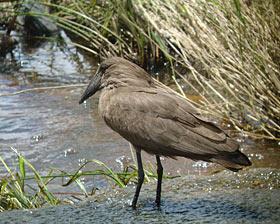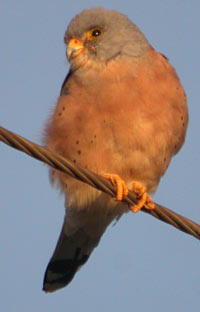UC Berkeley Press Release
 |
A new genetic study of birds shows that parrots, such as these African Fischer's lovebirds, are songbirds' closest relatives. As is true of many songbirds, parrots learn their songs from their parents. (Callan Cohen/UC Berkeley photos) |
Genetic study reshuffles bird family tree
BERKELEY – Dinosaurs developed feathers some 65 to 100 million years ago and became birds, with the ostriches and emus among the first to evolve, and the ducks and chickens next.
That much we know, says University of California, Berkeley, ornithologist Rauri Bowie. But when it comes to the rest of bird evolution, he adds, "nobody had any idea"- until now.
 These two unusual birds of the African continent, the shoebill (above) and the hammerkop (below), turn out to be one another's closest relative.  |
For example, parrots and songbirds turn out to be each other's closest relatives, while falcons are only distant cousins of the other birds of prey, the hawks and eagles. New world vultures like the turkey vulture are no longer classified with the storks, but rather, return to their more traditional placement with the hawks and eagles. And hummingbirds and swifts, long known to be closely related, are in the same group as the elusive nightjars and the whip-poor-will.
The study, led by The Field Museum of Chicago, involved gathering DNA from 169 species of birds representing nearly all of the world's non-songbird families. By sequencing genes from 14 different chromosomes, Bowie said, the researchers were able to make comparisons across regions from the whole bird genome, not just a small part of it. The group sequenced approximately 32 kilobases of aligned data per species, which is about five times more nuclear data than any previous study that focused on birds.
"The big problem has always been that birds diversified very quickly, in just a few million years - no one really knows why - so there is not much signal left in deciding who is related to whom," Bowie said, referring to the lack of living or fossil intermediate forms that could help scientists stitch together bird ancestry. Instead, scientists relied on morphology - the shape of bills and feathers - and bird behavior to guess relationships.
"We needed the scale of this study to retrieve enough information to start to resolve relationships," he said. "This DNA-based data provides an independent hypothesis people can look at for the evolution of different characters in birds."
The new relationships often make a lot of sense, said Bowie, an assistant professor of integrative biology and curator of birds at UC Berkeley's Museum of Vertebrate Zoology. For example, hummingbirds, swifts and nightjars all go into torpor at night or during cold weather. It thus makes sense that they are related, rather than having evolved this trait independently.
Similarly, many songbirds - which are by far the most diverse group of birds and make up 60 percent of the approximately 9,600 birds species - learn songs from their parents, just like many parrots, which are now revealed to be songbirds' closest relatives.
On the other hand, although falcons look superficially like hawks, the new data show them to be distantly related. In line with this new phylogeny, falcons are known to have traits, such as acute ultraviolet vision, that distinguish them from hawks and other birds of prey.
"These are just simple examples of how people are going to have to rethink the behavioral characters that have evolved," he said. "The study has raised as many questions as it has helped to resolve."
 The lesser kestrel, a small Eurasian falcon, is only distantly related to hawks and eagles, despite its resemblance to these birds of prey. |
"With this study, we learned two major things," noted Sushma Reddy, one of the three lead authors and a Bucksbaum Postdoctoral Fellow at The Field Museum. "First, appearances can be deceiving. Birds that look or act similar are not necessarily related. Second, much of bird classification and conventional wisdom on the evolutionary relationships of birds is wrong."
Bowie, who is interested in when and where African birds arose and how they evolved, contributed to the Early Bird Assembling the Tree-of-Life Research Project while he was a post-doctoral fellow at The Field Museum in 2003. He continued to work on it while in South Africa and also since his appointment to the UC Berkeley faculty in 2006. He helped analyze about 100 of the 169 bird species sampled.
He hopes to use the new phylogenetic data to understand the evolution of all of Africa's endemic bird families: how the species are related, when they arrived in Africa, how quickly the families radiated and how they adapted to different habitats.
Already, the data on African birds have provided surprises for Bowie. African mousebirds, an endemic order Bowie studies, seem closely related to owls, "which is a completely unexpected finding," he said. Just as bizarre is the apparent placement of another endemic order, the turacos - the only bird lineage able to manufacture its own color pigments - either at the base, or closely associated with, the large and wide-ranging group of water birds, including loons, penguins, albatrosses and pelicans. And two unique birds of the African continent, the stork-like shoebill and the hammerkop, turn out to be each other's closest relatives.
"I'm not saying that all of this is correct, but it certainly has raised a bunch of new questions," said Bowie. "What is really needed is finer scale detail; we need to add DNA from additional species to expand this backbone."
In addition to Reddy, the main authors of the study were Shannon Hackett, associate curator of birds at The Field Museum, and Rebecca Kimball, associate professor of zoology at the University of Florida, Gainesville.
The study's other co-authors were scientists from the Smithsonian Institution, Stellenbosch University in South Africa, the University of Maryland, Louisiana State University, Wayne State University and the University of New Mexico.
The study was funded by the National Science Foundation.

